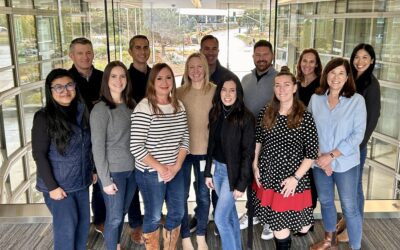This article originally appeared in The Modern Leadership Issue of Performance Matters Magazine. To request a print or digital copy of the magazine, click here.
Cultivating a healthy, high-performing organization where people are doing their best work and thriving requires significant effort, intentionality, and nurturing.
Ideally, every employee feels empowered to own their ability to thrive at work; yet leaders shape the experience of those they lead, and their impact is significant. To foster and sustain thriving, leaders must stay attuned to their team or organization’s health and how employees are experiencing their work.
How can leaders stay attuned to their impact on individual, team, and organizational health and performance? Assessment is a helpful starting point; through regular assessment, leaders can identify their strengths and opportunities to grow in their leadership capability as well as areas to focus future leadership development within the broader organization. (It’s important for leaders to regularly assess and stay attuned, because thriving, health, and performance can and will shift over time due to a variety of factors.)
We recommend gathering insight into six key questions that correspond to the needs of healthy, high-performing teams and organizations: purpose, potential, safety, capability, resources, and connection. (For more information on these needs, see Becoming a Healthy, High-Performing Organization.
We help leaders explore the following questions through employee surveys and interviews:
1. Do employees believe they’re doing meaningful work?
Research has shown that a strong organizational mission and sense of collective purpose contributes to several important outcomes—including increased financial performance, employee engagement, retention, and a sense of fulfillment among employees.1
Leaders can foster a collective sense of purpose by providing consistent articulation and reinforcement of the organization’s mission to employees. They also can foster this sense of purpose through conversation. This can look like leaders listening to employees when they say they don’t feel like they’re doing meaningful work; inviting employees to reflect on their sense of purpose at work; or asking employees if they understand the organization’s mission and how their work contributes to it.
If assessment reveals that employees are struggling to find meaning or connect their work to the organization’s mission or purpose, leaders can take action. First, show appreciation and provide feedback to help employees understand that their work matters—“connect the dots” to how their work matters and makes an impact on customers, products or services, or their colleagues. Where possible, help employees adjust their role to create a greater sense of meaning and fulfillment.
2. Do employees feel a sense of promise and potential?
When organizations have a collective sense of hope and optimism about the future, their employees tend to innovate, embrace challenges, and persevere in the face of setbacks and adversity. Yet these growth-oriented mindsets and behaviors can either be stifled or bolstered based on how leaders show up for their people.
Leaders can foster holistic growth and potential by observing external market trends and shifting dynamics, and then creating enthusiasm among employees about the associated opportunities. Similarly, leaders can articulate a shared vision that rallies and inspires the workforce to explore what might be possible (while also providing space for them to envision and dream big).
At the team or individual level, leaders can foster potential by giving employees the space and grace to stretch and grow outside their comfort zone (or the organization’s comfort zone). This looks like:
- Encouraging, recognizing, and rewarding employees’ novel ideas, innovation, and experimentation.
- Identifying factors that might limit growth, while creating equitable growth and development opportunities for all employees.
- Celebrating “failure” and acknowledge the learning that stems from trying something new (even if it isn’t ultimately “successful”).
3. Do employees feel safe and secure?
Leaders play a pivotal role in fostering a sense of safety among employees. One proven leadership practice for creating a psychologically safe environment is to model and invite open and candid dialogue. This requires from the leader high levels of courage, trust, vulnerability, and professional and personal biases. Leaders must be intimately attuned to the shadow they cast and how they respond (even in subtle ways) to the ambiguity that can arise when employees challenge the status quo or question assumed ways of working.
Leaders also foster a sense of security by communicating transparently with employees about if and when internal or market dynamics are threatening the team’s or organization’s stability, along with plans for weathering those threats. This enables employees to develop trust in leaders and feel secure that leaders aren’t withholding information that can impact their professional and personal well-being.
Inviting employees to bring their whole selves also contributes to a sense of safety and belonging. Employees are not just workers; they are parents, siblings, caregivers, friends, volunteers, and hobbyists with different life roles influencing who they are and what they bring to the workplace. Leaders who create a safe and secure environment recognize the humanity of each employee and celebrate when people authentically “show up” with their unique perspectives, personalities, emotions, work styles, and life experiences.
4. Do employees feel capable of applying their talents?
As stewards of the organization, leaders must ensure employees and teams have the necessary capabilities (including knowledge and skills) to fill critical roles in support of the mission. Leaders also can consider emerging capability needs arising from growth, operational changes, or new market opportunities. With these insights, leaders can guide strategic decisions to add talent or invest in existing talent through skills training and professional development.
Employees need to feel they’re contributing their skills and talents in meaningful ways to support the organization. If assessment reveals this isn’t the case, leaders should have conversations with employees to identify ways to leverage their skills in different roles; help employees assess their readiness to step into new roles; and identify and fill any skill gaps through development opportunities.
Investing in internal capability has a key byproduct: it demonstrates to existing employees that they are valued and appreciated; leadership sees their potential; and there’s a career path with opportunities for growth for them.
5. Do employees have the resources to do their best work?
Great talent requires appropriate resourcing to achieve its full potential. Resourcing is like fuel for an engine and includes a range of factors (e.g., time, support, rest, information, tools, training). Leaders play an important part in regularly assessing whether resource needs are being met and taking steps to close the gaps when they are not.
Being attuned to employee workload, work-life integration, and situations where employees are working excessive hours for extended periods of time is part of being an effective leader. For leaders, attuning to resourcing needs can look like:
- Attending to employees’ information needs by providing clear, consistent, and timely communications.
- Providing sufficient expectations, guidance, and feedback.
- Ensuring employees have access to necessary training and development to achieve the expectations of their roles.
- Prioritizing employee well-being and ensuring employees have adequate time, space, and rest for renewal of energy.
6. Do employees feel a sense of authentic, consistent connection?
Research shows that connection and belonging are crucial for health, well-being, and organizational performance. Since connections are formed through meaningful and authentic relationships, leaders can provide the space for employees to cultivate meaningful relationships. Leaders who “show up” with genuine vulnerability as full human beings with needs, challenges, and emotions are helping to cultivate an environment of trust and human connection that can ripple throughout the organization.
Leaders also have a critical role in cultivating a culture of inclusivity by helping individuals feel valued for who they are. This involves celebrating differences, actively seeking diverse perspectives, and ensuring that all employees have equal opportunities to contribute and succeed.
Leaders play a monumental role in cultivating a thriving organization.
To understand how people are experiencing their work, leaders can ask six core questions aligned to the needs of healthy, high-performing teams and organizations. Through assessment, leaders can identify where they need to shore up their leadership so the organization can thrive. Yet assessment is only the first step; leaders can use assessment results to draw insights and build an action plan to fortify and improve key areas of growth. The cycle of assessing, learning, and improving is ongoing for leaders who care about helping their teams and organizations thrive.
This article originally appeared in The Modern Leadership Issue of Performance Matters Magazine. To request a print or digital copy of the magazine, click here.




